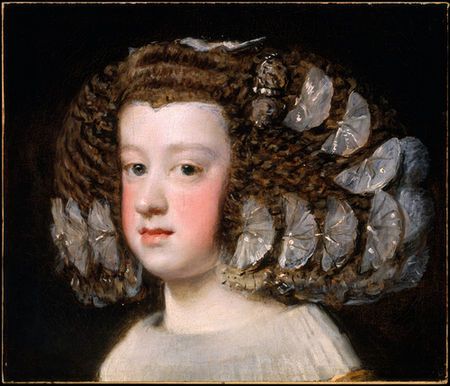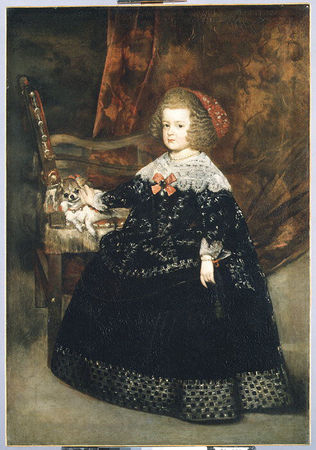'Velázquez Rediscovered' @ The Metropolitan Museum of Art
Diego Rodríguez de Silva y Velázquez (Spanish, 1599-1660), "Portrait of a Man". Oil on canvas. 27 x 21-3/4 inches. The Metropolitan Museum of Art, The Jules Bache Collection, 1949 49.7.42
NEW YORK, NY.- Velázquez Rediscovered, a special exhibition opening November 17 at The Metropolitan Museum of Art, will feature a newly identified painting by Velázquez, "Portrait of a Man", formerly ascribed by the Museum to the workshop of Velázquez and recently reattributed to the master himself following its cleaning and restoration. It will be shown alongside other works from the Museum's superior collection of works by the great Spanish painter.
In summer 2009, the arresting "Portrait of a Man" was taken off the walls of the gallery where it had been on view for many years and brought to the conservation studio for examination. Long obfuscated by thick, discolored layers of varnish and an old restoration that attempted to make it look more finished than the artist intended, the picture has emerged from its cleaning as an autograph work by the master: an informal portrait done from life, with parts left only summarily described, showing the hallmarks of Velázquez's sure touch of the brush. The painting is now confidently reattributed to Diego Rodríguez de Silva y Velázquez (1599– 1660).
"This reattribution to Velázquez of a work that has been in the Metropolitan Museum's collection for decades is the result of the fine collaborative work of two of the Museum's renowned experts: Keith Christiansen, John Pope-Hennessy Chairman of European Paintings, and Michael Gallagher, the Sherman Fairchild Conservator in Charge of Paintings Conservation," stated Thomas P. Campbell, Director of The Metropolitan Museum of Art. "It highlights the depth of the Museum's collection as well as the acumen of its superb curatorial and conservation staff."
The painting's fascinating history is notable for the changes in attribution and identification, providing a case study in the ways critical opinion can alter over time. The picture entered the collection in 1949 as part of the bequest of Jules Bache, who headed one of the most successful brokerage firms in the country before the Second World War, and who was an art collector of great distinction as well as one of the major benefactors of The Metropolitan Museum of Art. Acquired sometime before 1811 by Johann Ludwig Reichsgraf von Wallmoden-Gimborn (the illegitimate son of George II of Great Britain) and later in the collection of George V, King of Hanover, Duke of Brunswick-Lüneburg, Duke of Cumberland (1857–d. 1878), the picture was acquired by Bache from the famous dealer Joseph Duveen in 1926. At the time, it was considered by a leading specialist as a self-portrait of Velázquez, and as such it entered the Museum. However, more recent scholarship has had a less favorable view of the picture. In the standard 1963 monograph on the artist by José López-Rey, it is described as a "school piece rather close to Velázquez's manner." In 1979, the Museum demoted the attribution to the workshop of Velázquez. What was not realized was the degree to which heavy retouching and a thick, discolored varnish obfuscated the qualities of the picture.
Jonathan Brown, author of the authoritative monograph in English on the artist and a professor at New York University's Institute of Fine Arts, concurs that the work is indeed by the artist – most likely an informal, rapidly painted study, with the head more highly finished than the costume and background, which is a thinly painted gray over a warm pinkish-buff ground.
Many questions remain, the most intriguing of which is the identity of the sitter who gazes at the viewer with such intensity. As has long been recognized, the same person appears at the far right of Velázquez's masterpiece, "The Surrender of Breda" (Museo del Prado, Madrid), painted in 1634-35 to commemorate the Spanish victory over the Dutch. The placement of the figure—as an observer rather than a direct participant in the action, and the way he looks out at the viewer—has led some scholars to identify it as a self-portrait. The matter remains highly speculative. There is the question of his resemblance (or lack thereof) to bona-fide portraits of Velázquez and the fact that he is attired like other members of the Spanish contingent. Other depictions of Velázquez —most famously his inclusion of himself in his most celebrated masterpiece, "Las Meninas"— are all much later in date (Velázquez was 57 when he painted La Meninas). Thus the Museum has retained the title "Portrait of a Man".
Velázquez Rediscovered, a small, focused exhibition, will feature other Velázquez paintings from the Metropolitan Museum's collection such as "Don Gaspar de Guzmán" (1587-1645), "Count Duke of Olivares" (1638), "The Supper at Emmaus" (ca. 1622-23), "María Teresa" (1638-1683), "Infanta of Spain" (ca. 1651), and the celebrated "Juan de Pareja" (ca. 1610-1670). Other works on view will include "María Teresa" (1638-1683) by Velázquez's gifted pupil and son-in-law, Juan Bautista Martínez del Mazo (1612- 1667).
Velázquez Rediscovered is organized by Keith Christiansen, John Pope-Hennessy Chairman of European Paintings at The Metropolitan Museum of Art.
Diego Rodríguez de Silva y Velázquez (Spanish, 1599–1660), Don Gaspar de Guzmán (1587–1645), Count-Duke of Olivares, ca. 1635. Oil on canvas, 50 1/4 x 41 in. (127.6 x 104.1 cm) The Metropolitan Museum of Art, Fletcher Fund, 1952. 52.125
Diego Rodríguez de Silva y Velázquez (Spanish, 1599–1660), The Supper at Emmaus, 1622–23. Oil on canvas, 48 1/2 x 52 1/4 in. (123.2 x 132.7 cm). The Metropolitan Museum of Art, Bequest of Benjamin Altman, 1913, 14.40.631
Diego Rodríguez de Silva y Velázquez (Spanish, 1599–1660), María Teresa (1638–1683), Infanta of Spain, 1651–54. Oil on canvas. Overall 13 1/2 x 15 3/4 in. (34.3 x 40 cm); original painted surface 12 7/8 x 15 1/8 in. (32.7 x 38.4 cm) The Metropolitan Museum of Art, The Jules Bache Collection, 1949. 49.7.43
Diego Rodríguez de Silva y Velázquez (Spanish, 1599–1660), Juan de Pareja (born about 1610, died 1670), 1650. Oil on canvas, 32 x 27 1/2 in. (81.3 x 69.9 cm) The Metropolitan Museum of Art, Purchase, Fletcher and Rogers Funds, and Bequest of Miss Adelaide Milton de Groot (1876–1967), by exchange, supplemented by gifts from friends of the Museum, 1971. 1971.86
Juan Bautista Martínez del Mazo (Spanish, born about 1612, died 1667), María Teresa (1638–1683), Infanta of Spain, 1644–45. Oil on canvas, 58 1/4 x 40 1/2 in. (148 x 102.9 cm) The Metropolitan Museum of Art, Rogers Fund, 1943. 43.101

/https%3A%2F%2Fprofilepics.canalblog.com%2Fprofilepics%2F1%2F0%2F100183.jpg)








/http%3A%2F%2Fstorage.canalblog.com%2F27%2F13%2F119589%2F61363563_p.jpg)
/http%3A%2F%2Fstorage.canalblog.com%2F62%2F53%2F119589%2F53553801_p.jpg)
/http%3A%2F%2Fstorage.canalblog.com%2F64%2F29%2F119589%2F53156328_p.jpg)
/http%3A%2F%2Fstorage.canalblog.com%2F21%2F73%2F119589%2F41852139_p.jpg)